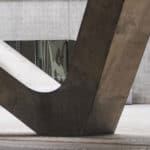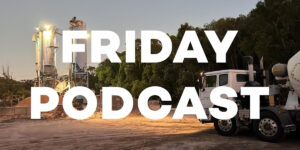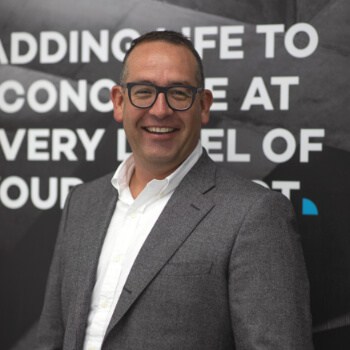We are introduced to MARKHAM’s new podcast series; Doug shares some of the fundamental issues faced in preserving concrete’s durability; and Mark gives us some history of MARKHAM and why INVISIBLE STRENGTH is such an apt over-arching summary of what we do.
Invisible Strength

Invisible Strength
Invisible Strength
/
RSS Feed
View the Transcript
NIKKI: Kia ora and g’day everyone, welcome to Markham’s very first podcast episode. Obviously we’re very excited, and we’ve still got our training wheels bolted on! I’m Nikki Horn, Markham’s Project Manager for New Zealand, and if you’ve worked on a project in the past couple of years, no doubt you’ll have spoken to me. It’s great to have you listening today!
This is the first topic of our series, Invisible Strength. We’re keen to get into the science and practical challenges of concrete from the inside out – the science and the challenges you can’t necessarily see.
With me as we walk through this topic is Doug Hamlin, our Research and Development Manager. Doug, give a shout to our audience!
DOUG: Thanks Nikki, and yes, I’m excited about joining this new podcast series. It’s going to be practical stuff, learned through real experience, not just hypotheticals. Of course, we’re going to dive a little bit into the science, although mostly going to keep it simple. So we’re hoping to include relevant industry experts in future segments, but as Nikki says it is training wheels today!
NIKKI: That’s great, Doug. And shortly we’ll bring on a special guest, who we will introduce in due course. So Doug, where exactly is today’s topic coming from? Invisible strength, what does that even mean for concrete?
DOUG: OK, so this might seem a bit simplistic to start with, but stay with me! We all know that concrete is strong and durable. It’s one of the key reasons it is used, of course. And tied to that is durability, you know, how long it lasts. But looking at two different slabs of concrete, you can’t necessarily tell which one is stronger – you can’t visibly tell the differences in mix design or strength or intended service life. So you know, it generally looks grey mostly! So what we want to do here is talk about what’s going on inside the concrete – what makes it stronger, what makes it weaker, and how we can help. And ultimately those things are invisible. Concrete’s failures can end up being very visible, but leading up to those failures … and its strength is invisible.
NIKKI: That’s a keen way to look at it – the failures are very visible but the strength is invisible! So tell us about what’s going on inside concrete. What makes it strong, and conversely what can go wrong?
DOUG: To quickly go over some of the basic stuff: Concrete of course is mixed from Portland cement, along with sand and aggregates, and very importantly, water. Reinforcing steel or fibres are used to enhance flexural strength and give concrete tensile strength to allow larger or more irregular elements to be created. The mix cures and hardens, it forms calcium-silicate-hydrate molecules, or C-S-H, and these molecules give it compressive strength. So in a nutshell, that’s what makes it very strong. Very simply, of course.
So what can go wrong is that contaminating chemicals move into the concrete and react, either with the concrete itself or with the reinforcing steel, and cause cracking. Now these contaminants are carried by moisture – whether that’s water, or water vapour. They come in through tiny cracks or pores, that’s P-O-R-E-S not the concrete pour, and then as the internal reactions happen the cracks open up wider and the situation gets worse. So the first thing people notice about deterioration is more visible cracking and possibly rust stains due to steel corrosion.
NIKKI: That sounds less than ideal! And that’s that invisible weakness you were talking about. How can we stop that happening?
DOUG: Well there is an advanced method. Nikki, you mentioned our special guest earlier, I think it’s time to include him!
NIKKI: OK! And now for some insights from our CEO, Mark Smith! Mark, please introduce yourself!
MARK: Thank you Nikki, great to be on board this podcast today! So I’m really proud to think that Markham has been operating back since 1996, that’s 25 years, and it’s been an amazing journey. In these podcasts I believe our team is really sharing some of the experience and knowledge that we’ve gathered up along the way, and I think we can be very proud of our knowledge into the hydrogel space.
NIKKI: Awesome, thank you, Mark! Can you share with us how we can arrest the deterioration that Doug’s been talking about?
MARK: Well the secret is – everyone across the world internationally recognizes that immobilizing moisture inside concrete stops the corrosion and deterioration of the embedded reinforcing steel. And we do that with colloidal silica treatments, which bind the moisture into a hydrogel inside the concrete. So I want you to think of it as like ‘embalming’ the concrete structure. So not only will we stop the moisture entering the concrete porosities, and moving through the concrete, but we stop the contaminants that are moving around the concrete. Stop feeding the reactions which are happening inside the concrete. And why I relate to embalming is because – surface coatings are just like having a raincoat on, on a humid day, you still sweat inside your raincoat. Well, structures still ‘sweat’ if you just put a surface coating on them, versus putting a hydrogel that is going into the porosities is actually ‘embalming’ the structure, and it’s undisputable that embalming makes things last longer.
Obviously I’m a long-standing fan of hydrogel treatments, which have been proven in the field in for many many years. Markham alone has got projects going back 25 years. And I don’t know of any project of the – close to 25 million square metres now – that we have ever re-treated.
So, our biggest thing for me, is, it’s actually an INVISIBLE STRENGTH. You can’t see Aquron working, you’ll never be able to see it working from a scientific level – but you can see the result of it embalming the concrete: structures lasting longer. You can see that, you go back to structures that have been – many years before – so the INVISIBLE STRENGTH is really what I love about it.
NIKKI: Cool! And the Invisible Strength will actually be the topic we move forward with, for the beginning of this podcast series. So Mark, can you please tell us about some projects where this has been proven effective, maybe some of the ones that stand out in your mind?
MARK: Well, one of them would be the Bledisloe Wharf, for Ports of Auckland. We went in there, and there were known chloride levels. We actually had, contractually had a bond in there to prove that our product would work. And we were so sure – part of our Be Sure values! – that we would perform, that we were happy to sign that bond, and 15 years later that was released. So that was done in year 2000. And we went back and actually had a look, and we had effectively … the corrosion levels had not changed. So we’d effectively halted that corrosion process for that period of time. So people, in the life cycle of structures, can know that they can put it for a period of time and re-evaluate.
But as far as we’re concerned, unlike other treatments that have to be re-applied at every 10 to 15 years – Aquron doesn’t need to be re-done, it’s permanent. And that is an invisible strength.
So another example that I think we can really talk about ‘invisible strength’ is the millions of square metres that we have done to protect moisture moving through concrete to delaminate floor coverings. Now we’re doing up to 150,000 square metres every single month. So for me to just single out one project is pretty hard. But I can proudly say that we’re invisible strength by protecting all of those floor coverings – so that they don’t delaminate, so it actually keeps people’s timeframes in the construction program on track, so it’s saving time and money. But secondly the invisible strength is – if you go back at a later date and replace those floor coverings because they’re worn out, you don’t ever re-do Aquron. Aquron is inside the concrete, invisibly protecting the moisture from moving. You can diamond-grind that surface after it’s been Aquron’d, you won’t remove the Aquron function. So again, real good example of it being an invisible strength.
So it’s not just for one concrete structure. We can embalm a wharf or we can protect from moisture underneath floor coverings. But another major area where we’re being an invisible strength is for exposed floors. Whether it be a car park, or whether it be a distribution centre. You can’t see Aquron on the surface. It’s a treatment that gives you internal curing right at day one, an invisible cure because it’s not a membrane. And then it’s an invisible hardener and anti-dusting treatment. And if you go back – I went back to a project that was 10 years old, the other day, and if you look down at the concrete when you’re standing at it, there’s not a gloss at your feet. But if you walk down to the other end of the project, you can actually see a sheen right across that floor. And that is part of the work-hardening effect of – I say, the more you use it, the better it gets.
And in an exposed car park situation which is broom-finished, where I say we have an invisible strength is, I’m super-proud to walk back into a car park 10 years, 15 years later – and there’s multiple that I can go back through – and you can see the original broom finish marks where the concrete layer did it on day one. Now that’s invisible strength. There’s not a film, there’s not a coating, there’s not a membrane.
And so, it doesn’t matter which way you look at it – Aquron, and hydrogels, nano-silicas, are an invisible strength in concrete.
And the industry really needs to start understanding, that the way you see how these products work is by result. They don’t apply to the same testing regimes as membranes and all those different things, because they have a completely different mode, or function.
So at the end of the day, INVISIBLE STRENGTH is just such a good over-arching topic, and I could sit here for hours telling you about every different project we’ve done. And I’ve actually personally been on site and physically done more than 500,000 square metres of concrete treatment myself. Whether it be under wharves – that’s spraying up under wharves – or whether it’s been spraying a floor slab, a multi-level car park, whether it’s been a retail slab, or an aged care. They all, you can say, Aquron is there as invisible strength, and so I’m super-proud about that.
NIKKI: That’s so good, Mark, thank you! Great to get those real-life examples. And we’re keen to talk about projects and concrete issues that our listeners are faced with today! So Mark, if I’m a client, how do I get in touch?
MARK: So for me, the best place to go is www.markhamglobal.com Find the product you like – download the information – tell us about the project – and one of our team will get back to you within 24 hours. And I would pride ourselves in being the fastest responding team in the industry.
NIKKI: Cool, thank you so much, Mark! We’re happy to take any suggestions for topics on board. What are your concrete pain points in the field? How can we help to educate the industry?
Thank you so much for listening, don’t miss our next episodes!
Want to Contribute?
Feedback on our podcasts? Suggestions for future topics? Looking for more information on topics we’ve discussed? Send us a message – we’ll be in touch within a day or two.
More about MARKHAM
MARKHAM are dedicated to providing innovations for concrete and construction. Focusing on concrete waterproofing solutions, penetrating concrete sealers and durability treatments for concrete.
Podcast Categories
Latest Episodes

Doug & Laike Share Their Week – Western Australia, Christchurch, and a Focus on Low Carbon Concrete
Laike and Doug wrap up their week again with a 10-minute chat. They’ve each been

Doug & Henry Share Their Week – R&D, Melbourne Traffic, Basement Waterproofing, And ‘CONQOR Your Health’
It’s Henry’s turn to join Doug in the podcast studio – in person this time!

Doug & Laike Share Their Week – Seychelles, Readymix Plants, And A Bike Ride
Once again Doug and Laike sit down for a 10 minute recap from the week.
invisible strength podcast
The whole MARKHAM team is pleased to present you with our podcast series, INVISIBLE STRENGTH. In this series of interviews, we’ll walk through the science and challenges of concrete durability, what goes wrong in the field – and the advanced methods available to restore and enhance service life to concrete construction.
INVISIBLE STRENGTH reflects a number of factors in concrete construction and durability. When things go wrong, the evidence can become very visible indeed. However, when all is going well, there’s nothing particular to be seen!
MARKHAM’s concrete treatments, too, are invisible once completed – and the result is the long internal, invisible durability of the concrete.
So join us as we explore the unseen world inside concrete – why it matters, and how it can be protected!


